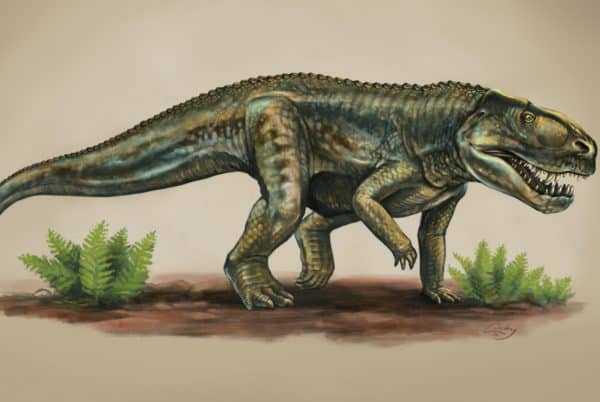
 A new species of extinct reptile said to be distant cousins with crocodiles has been identified by an undergraduate student working in a lab at Virginia Tech. This gigantic ancient crocodile was newly named Vivaron haydeni.
A new species of extinct reptile said to be distant cousins with crocodiles has been identified by an undergraduate student working in a lab at Virginia Tech. This gigantic ancient crocodile was newly named Vivaron haydeni.
This reptilian is thought to have lived during the Late Triassic period about 200 million years ago at a time when the first dinosaurs and mammals were only just emerging. Measuring between 12 and 18 feet in length and walking on all fours, Vivaron was a member of the Rauisuchidae group of predatory animals who once reigned over the supercontinent Pangea and now have modern crocodile as distant relatives.
“These were some of the biggest predators at the time; all dinosaurs were much smaller,” says Dr. Sterling Nesbitt, assistant professor of geosciences at Virginia Tech and co-author of the study, now published in the journal PeerJ.
The new discovery is due to the efforts of undergraduate student Emily Lessner who was working in Nesbitt’s lab when she happened upon a stored set of fossils previously dug up in 2009 from a quarry in Ghost Ranch, New Mexico.
“Initially, I cleaned fossils in the lab and worked on a project reconstructing soft tissue structures using computed tomographic, or CT, scans on the computer,” says Lessner, now a senior majoring in biological sciences at Virginia Tech. “I began looking at Vivaron pretty soon after.”
While only a small number of skeletal fragments for Vivaron were recovered, it was enough to designate a new species, particularly due to the unique rear-facing prongs located on the upper jaw bone. Researchers say that the fossils put Vivaron as a relative of Teratosaurus suevicus, another rauisuchid from the same period which so far has only been unearthed on the other side of the planet in Germany. “Despite their geographic separation, this morphological evidence implies a close phylogenetic relationship between V. haydeni and T. suevicus,” say the study’s authors.
The new reptile gets its name from John Hayden, a hiker who first discovered the Hayden Quarry in northern New Mexico in 2002 and from the mythical 30 foot rattlesnake spirit called the Vivaron which, so goes the legend, lived under the Orphan Mesa at Ghost Ranch.
“Vivaron haydeni is the second rauisuchid taxon discovered from the Triassic of the southwestern United States,” say the authors.
The Triassic period came to an abrupt end sometime between 208 and 213 million years ago at the onset of a mass extinction event which killed off 70 to 80 per cent of all species, including many reptiles and early dinosaurs. Scientists believe that the change was brought about by a sudden warming of the planet, likely caused by shifting in the Earth’s tectonic plates which were pulling Pangea apart at the time, bringing molten rock, magma and gas to the surface in huge quantities.
Important evidence of the mass extinction and its aftermath is currently being uncovered at Wasson Bluff in Nova Scotia’s Bay of Fundy, where cliff erosion has opened up access to rock formations from the early days of the Jurassic period, containing fossils of reptiles and dinosaurs who survived the extinction.
“These animals whose bones are found in this red sandstone along the shores of Parrsboro … they represent the survivors of this mass extinction,” says Tim Fedak, curator of the Fundy Geological Museum, in conversation with the CBC. “By collecting all of the specimens that we can, we’re able to establish a really rich record of what survived that mass extinction and perhaps start answering questions about why they have.”
Leave a Reply
You must be logged in to post a comment.



 Share
Share Tweet
Tweet Share
Share




Comment